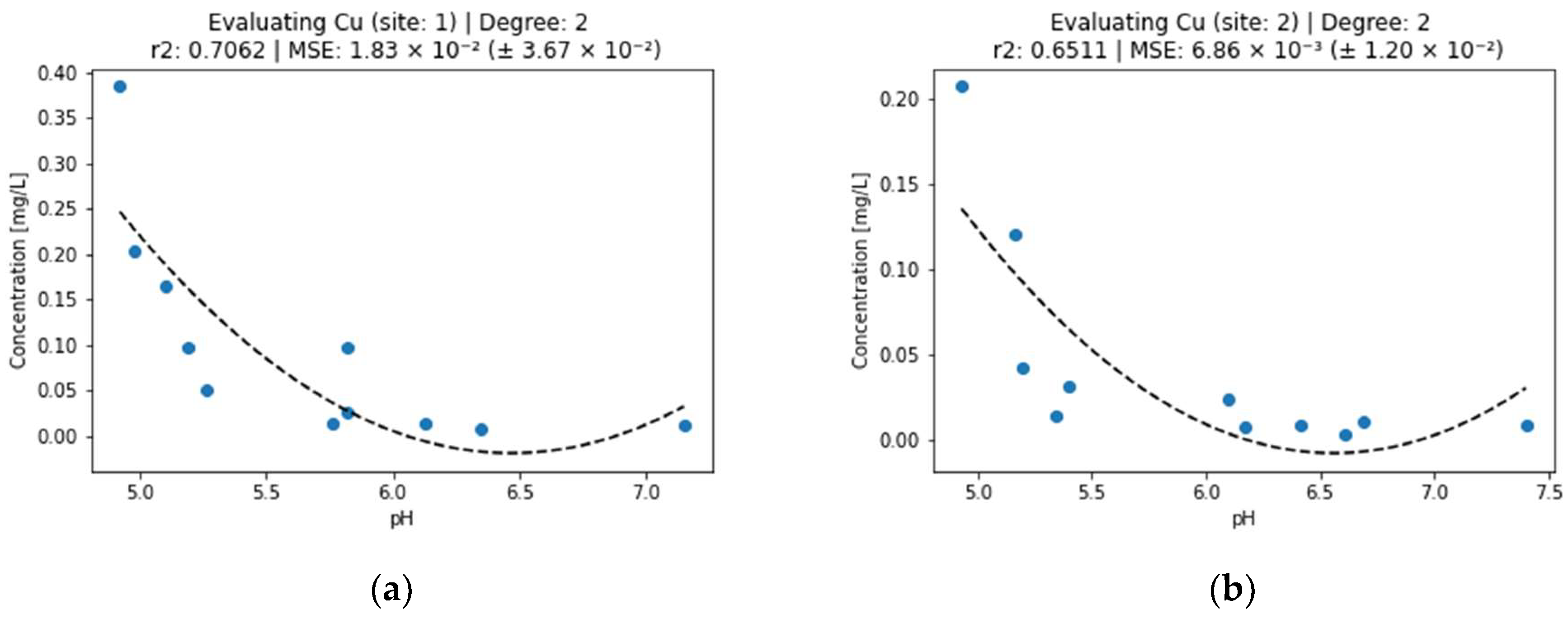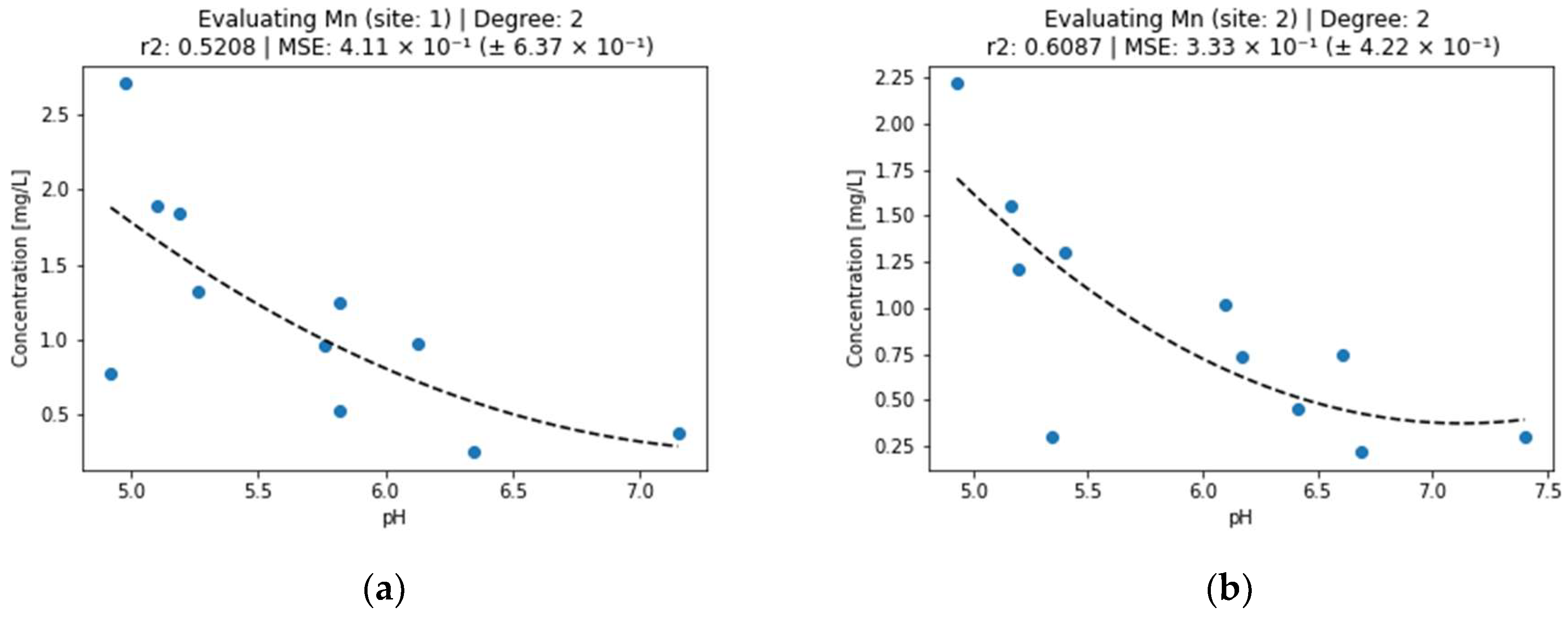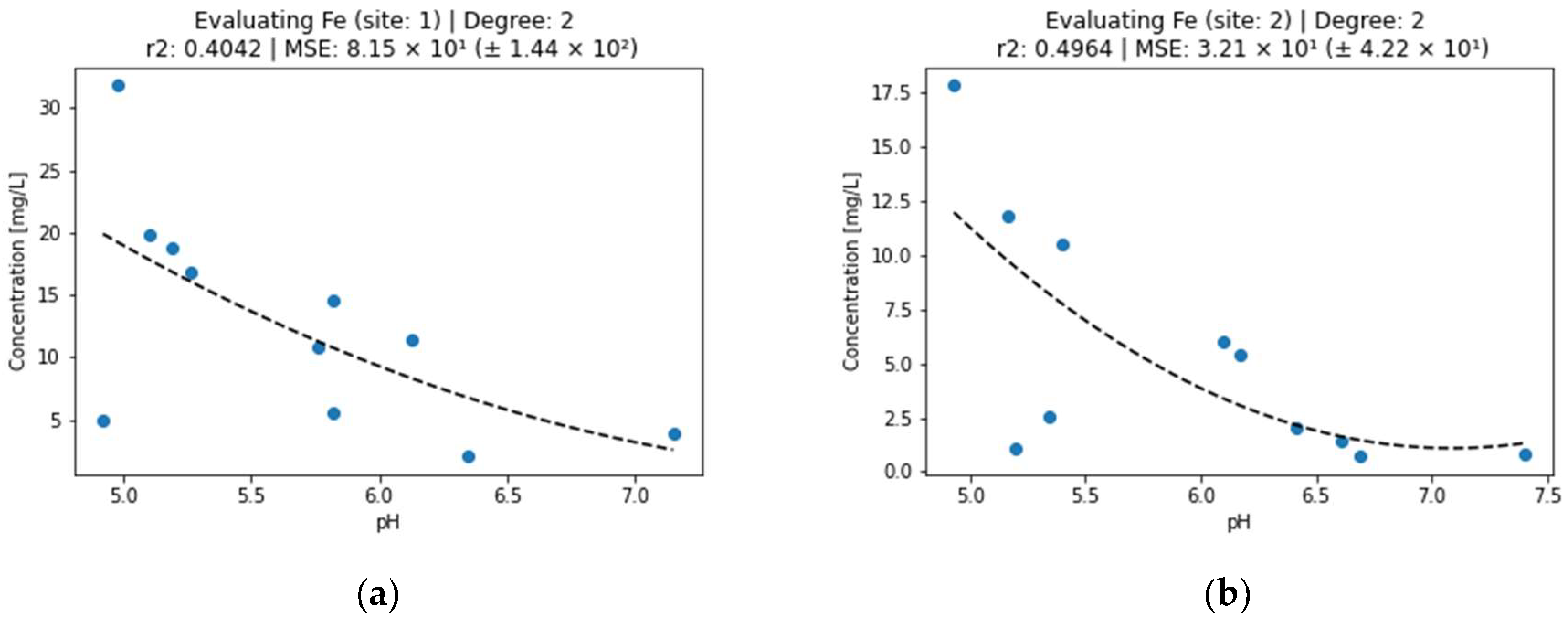The Influence of Acidic Mine Waters on Physico-Chemical Processes in the Aquatic Environment †
Abstract
:1. Introduction
2. Materials and Methods
3. Results and Discussion
4. Conclusions
Author Contributions
Funding
Institutional Review Board Statement
Informed Consent Statement
Data Availability Statement
Conflicts of Interest
References
- Akcil, A.; Koldas, K. Acid mine drainage (AMD): Causes, treatment and case studies. J. Clean. Prod. 2006, 14, 1139–1146. [Google Scholar] [CrossRef]
- Lintnerová, O.; Šottník, P.; Šoltés, S. Abandoned Smolnik mine (Slovakia) a catchment area affected by mining activities. Estonian J. Earth Sci. 2008, 57, 104–110. [Google Scholar] [CrossRef]
- Dvořáček, J.; Malíková, P.; Sousedíková, R.; Heviánková, S.; Rys, P.; Osičková, I. Water production as an option for utilizing closed underground mines. J. S. Afr. Inst. Min. Metall. 2022, 122, 571–577. [Google Scholar]
- Skousen, J.G.; Ziemkiewicz, P.F.; McDonald, L.M. Acid mine drainage formation, control and treatment: Approaches and strategies. Extr. Ind. Soc. 2019, 6, 241–249. [Google Scholar] [CrossRef]
- Yuan, J.; Ding, Z.; Bi, Y.; Li, J.; Wen, S.; Bai, S. Resource Utilization of Acid Mine Drainage (AMD): A Review. Water 2022, 14, 2385. [Google Scholar] [CrossRef]
- Nishimoto, N.; Yamamoto, Y.; Yamagata, S.; Igarashi, T.; Tomiyama, S. Acid Mine Drainage Sources and Impact on Groundwater at the Osarizawa Mine, Japan. Minerals 2021, 11, 998. [Google Scholar] [CrossRef]
- Valová, B.; Kotalová, I.; Heviánková, S. Determination of Risk Elements in Mine Waste Dump Soil Sample Using Sequential BCR Extraction. Inzynieria Miner. 2020, 2020, 217–220. [Google Scholar]
- Archundia, D.; Prado-Pano, B.; González-Méndez, B.; Loredo-Portales, R.; Molina-Freaner, F. Water resources affected by potentially toxic elements in an area under current and historical mining in northwestern Mexico. Environ. Monit. Assess. 2021, 193, 236. [Google Scholar] [CrossRef]
- Johnson, D.B.; Hallberg, K.B. Acid mine drainage remediation options: A review. Sci. Total Environ. 2005, 338, 3–14. [Google Scholar] [CrossRef]
- Andras, P.; Adam, M.; Chovan, M.; Slesarova, A. Environmental hazards of the bacterial leaching of ore minerals from waste at the Pezinok deposit (Malé Karpaty MTS., Slovakia). Carpathian J. Earth Environ. Sci. 2008, 3, 7–22. [Google Scholar]
- Hakansson, K.; Karlsson, S.; Allard, B. Effects of pH on the accumulation and redistribution of metals in polluted stream bed sediment. Sci. Total Environ. 1989, 87/88, 43–57. [Google Scholar] [CrossRef]
- Luptakova, A.; Kusnierova, M. Bioremediation of Acid Mine Drainage by SRB. Hydrometallurgy 2005, 77, 97–102. [Google Scholar] [CrossRef]
- Singovszka, E.; Balintova, M.; Holub, M. Heavy metal contamination and its indexing approach for sediment in Smolnik creek (Slovakia). Clean Technol. Environ. Policy 2016, 18, 305–313. [Google Scholar] [CrossRef]
- Bajtoš, P. Mine waters in the Slovak part of the Western Carpathians: Distribution, classification and related environmental issues. Slovak Geol. Mag. 2016, 16, 139–158. [Google Scholar]
- Kupka, D.; Pállová, Z.; Horňáková, A.; Achimovičová, M.; Kavečanský, V. Effluent water quality and the ochre deposit characteristics of the abandoned Smolnik mine, East Slovakia. Acta Montan. Slovaca 2012, 17, 56–64. [Google Scholar]
- Lintnerová, O.; Šottník, P.; Šoltés, S. Stream sediment and soil pollution in the Smolnik mining area (Slovakia). Slovak Geol. Mag. 2003, 9, 201–203. [Google Scholar]
- Calmano, W.; Hong, J.; Forstner, U. Binding and mobilization of heavy metals in contaminated sediments affected by pH and redox potential. Water Sci. Technol. 1993, 28, 223–235. [Google Scholar] [CrossRef]
- Balintova, M.; Singovszka, E.; Vodicka, R.; Purcz, P. Statistical Evaluation of Dependence Between pH, Metal Contaminants, and Flow Rate in the AMD-Affected Smolnik Creek. Mine Water Environ. 2016, 35, 10–17. [Google Scholar] [CrossRef]
- Kruopiene, J. Distribution of Heavy Metals in Sediments of the Nemunas River (Lithuania). Polish J. Environ. Stud. 2007, 16, 715–722. [Google Scholar]
- Balintova, M.; Petrilakova, A. Study of pH Influence on Selective Precipitation of Heavy Metals from Acid Mine Drainage. Chem. Eng. Trans. 2011, 25, 345–350. [Google Scholar]
- Funes, A.; De Vicente, J.; Cruz-Pizarro, L.; De Vicente, I. The influence of pH on manganese removal by magnetic microparticles in solution. Water Res. 2014, 53, 110–122. [Google Scholar] [CrossRef] [PubMed]
- Feng, D.; Aldrich, C.; Tan, H. Treatment of acid mine water by use of heavy metal precipitation and ion exchange. Miner. Eng. 2000, 13, 623–642. [Google Scholar] [CrossRef]
- Balintova, M.; Petrilakova, A.; Singovszka, E. Study of metal ion sorption from acidic solutions. Theor. Found. Chem. Eng. 2012, 46, 727–731. [Google Scholar] [CrossRef]
- Balintova, M.; Petrilakova, A.; Singovszka, E. Study of metals distribution between water and sediment in the Smolnik Creek (Slovakia) contaminated by acid mine drainage. Chem. Eng. Trans. 2012, 28, 73–78. [Google Scholar]
- Luptakova, A.; Balintova, M.; Jencarova, J.; Macingova, E.; Prascakova, M. Metals recovery from acid mine damage. Nova Biotechnol. 2010, 22, 1111–1118. [Google Scholar]
- Pedregosa, F.; Varoquaux, G.; Gramfort, A.; Michel, V.; Thirion, B.; Grisel, O.; Blondel, M.; Prettenhofer, P.; Weiss, R.; Dubourg, V.; et al. Scikit-learn: Machine Learning in Python. J. Mach. Learn. Res. 2011, 12, 2825–2830. [Google Scholar]
- Xinchao, W.; Roger, C.; Viadero, J.; Karen, M. Recovery of Iron and Aluminum from Acid Mine Drainage by Selective Precipitation. Environ. Eng. Sci. 2005, 22, 745–755. [Google Scholar]
- Jenke, D.R.; Diebold, F.E. Recovery of valuable metals from acid mine drainage by selective titration. Waters Res. 1983, 17, 1585–1590. [Google Scholar] [CrossRef]
- Kulkarni, S.J. A Review on Studies and Research on Manganese Removal. Int. J. Sci. Res. 2016, 1, 45–48. [Google Scholar]
- Patil, D.S.; Chavan, S.M.; Oubagaranadin, J.U.K. A review of technologies for manganese removal from wastewaters. J. Environ. Chem. Eng. 2016, 4, 468–487. [Google Scholar] [CrossRef]





| Sampling Site | |||||
|---|---|---|---|---|---|
| Parameter | Pech Shaft | 1 | 2 | Limits | |
| Fe | 322.70 ± 87.60 | 12.7 ± 8.9 | 5.46 ± 5.64 | 2.00 | |
| Mn | 25.30 ± 6.30 | 1.17 ± 0.74 | 0.91 ± 0.62 | 0.30 | |
| Al | [mg/L] | 65.1 ± 19.4 | 1.17 ± 1.60 | 0.35 ± 0.72 | 0.20 |
| Cu | 1.51± 0.74 | 0.097 ± 0.116 | 0.043 ± 0.64 | 0.02 | |
| Zn | 7.23 ± 2.27 | 0.349 ± 0.250 | 0.254 ± 0.213 | 0.10 | |
| pH | 4.0 ± 0.1 | 5.8 ± 1.1 | 6.1 ± 1.1 | 6.0–8.5 | |
Disclaimer/Publisher’s Note: The statements, opinions and data contained in all publications are solely those of the individual author(s) and contributor(s) and not of MDPI and/or the editor(s). MDPI and/or the editor(s) disclaim responsibility for any injury to people or property resulting from any ideas, methods, instructions or products referred to in the content. |
© 2023 by the authors. Licensee MDPI, Basel, Switzerland. This article is an open access article distributed under the terms and conditions of the Creative Commons Attribution (CC BY) license (https://creativecommons.org/licenses/by/4.0/).
Share and Cite
Balintova, M.; Junakova, N.; Chernysh, Y. The Influence of Acidic Mine Waters on Physico-Chemical Processes in the Aquatic Environment. Eng. Proc. 2023, 57, 4. https://doi.org/10.3390/engproc2023057004
Balintova M, Junakova N, Chernysh Y. The Influence of Acidic Mine Waters on Physico-Chemical Processes in the Aquatic Environment. Engineering Proceedings. 2023; 57(1):4. https://doi.org/10.3390/engproc2023057004
Chicago/Turabian StyleBalintova, Magdalena, Natalia Junakova, and Yelizaveta Chernysh. 2023. "The Influence of Acidic Mine Waters on Physico-Chemical Processes in the Aquatic Environment" Engineering Proceedings 57, no. 1: 4. https://doi.org/10.3390/engproc2023057004
APA StyleBalintova, M., Junakova, N., & Chernysh, Y. (2023). The Influence of Acidic Mine Waters on Physico-Chemical Processes in the Aquatic Environment. Engineering Proceedings, 57(1), 4. https://doi.org/10.3390/engproc2023057004








